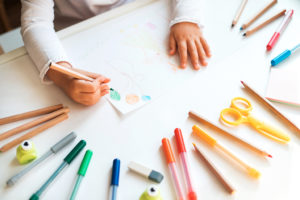
In the span of just a few weeks, the COVID-19 virus has managed to uproot daily routines and disrupt the natural order.
Schools, restaurants and businesses have temporarily closed or abandoned in-person services. Sporting events and large gatherings have been canceled. When possible, folks are working from home.
The arrangements are unprecedented and, for many, unsettling.
Now imagine, for a moment, how kids might feel about these strange happenings.
For them, the world is a whole lot bigger. Less controllable. Less predictable.
“It’s all brand new for them, just like it’s brand new for us,” said Brittany Barber Garcia, PhD, a pediatric psychologist with Spectrum Health Helen DeVos Children’s Hospital.
Young children in particular will look to adults to reassure them during difficult times.
Dr. Barber Garcia recommends two surefire strategies adults and caregivers can use to keep kids on track through disruptive times: Communicate openly and commit to routines.
Open communication
Parents and caregivers should strive to reassure kids and empower them with knowledge, Dr. Barber Garcia said.
Don’t try to close young ones off from reality. It only invites uncertainty.
“They don’t know and they’re in the dark,” Dr. Barber Garcia said. “That can make it scary for them. It won’t do any good—in fact, it could do more harm—if you avoid the topic.”
Information, delivered the right way at the right time, is empowering.
“As adults, when we are uncertain about something, it is more difficult for us to cope with it,” she said. “Usually, once we know what it is, it is easier to cope.”
Kids are the same way. They want to know.
But while parents and older kids can glue themselves to social media and the news for updates on COVID-19—don’t do that, by the way—young children have only a limited number of places to get information.
Don’t make the mistake of thinking kids aren’t picking up on things from peripheral sources.
TVs blare in the background. Ads target social media and games. Relatives whisper about grocery shortages.
“We know they’re perceiving some of it, but we tend to underestimate how much they’re getting and how much they know,” Dr. Barber Garcia said. “They usually know a little more than we think. And they’re actively coping with all that information.
“It behooves us as adults and caregivers to help them with that process.”
How best to do that? Communicate—openly and honestly.
“The advice is out there, but it bears repeating,” she said. “The most important thing you can do with your children is keep the lines of communication open.
“This doesn’t mean barrage them with information,” she said. “It does mean regularly ask questions that let them know that you are interested in their thoughts and want to respond to their questions or concerns.”
Conversations lead to reassurance and knowledge, which allows an individual to take action that can keep them safer.
“It’s very empowering to them to be able to know what is within their control that they can do,” Dr. Barber Garcia said. “Not only will this help keep them healthy and safe, it will help them feel safe and secure, too.”
The sure route: Figure out the facts.
“What are the facts? What’s true? How can we use that to stay calm?” Dr. Barber Garcia said.
If you aren’t sure, get information from trusted sources, such as the Centers for Disease Control and Prevention and the Spectrum Health COVID-19 information site, she said.
A 6-year-old boy can’t understand the molecular assays scrutinizing the potentially zoonotic origins and pathophysiology of COVID-19.
He can, however, understand that germs are harmful and hand-washing is the best defense.
It’s simple, true information that leads to productive action.
“Staying close to the facts allows you the opportunity to present information in a way that provides reassurance and helpful, protective action,” Dr. Barber Garcia said.
Stick to it
Maintain old routines as much as possible and, as needed, establish healthy new ones.
“Not going to school is a massive change in routine for kids of any age,” Dr. Barber Garcia said. “If we abandon all of the other expectations we have for kids, too, they may begin to become fearful of what that means, because regular expectations and routines convey safety and comfort to kids.”
So you have to keep expectations in place, she said.
“Even simple things like changing from pajamas to clothes each morning and eating meals at the normal times for your family can help to provide the structure and stability kids needs to feel safe,” she said.
“Keep their routines as normal and consistent as possible, even if you as a caregiver are undergoing massive change,” she said.
Be direct
No matter your child’s age, keep the lines of communication open with direct questions and clear answers, said Brittany Barber Garcia, PhD, a pediatric psychologist with Spectrum Health Helen DeVos Children’s Hospital.
“Initiate conversations with questions about what your kids know and how they’re feeling,” she said. “You won’t put them off by being direct. Your kid isn’t going to shut down because you asked it the wrong way.”
Similarly, provide answers that are factual, age-appropriate and clear.
Don’t give false reassurance, such as, “No one in your school will get it.”
Do offer clear strategies about what kids can do to keep themselves and people they love safe. (Say: “Let’s all try to wash our hands five times per day.”)
Teens are often more responsive to open-ended questions, while elementary-age children may respond better to straightforward questions.
“If it’s an open line of communication between you—the caregiver—and the child, it doesn’t matter if you asked the question the right way, though,” Dr. Barber Garcia said. “What matters more is that you’re there, listening to them, offering calm answers and support.”
For starters: Re-establish the educational process at home.
In some ways, society is now more uniquely positioned to handle a pandemic than ever before.
The across-the-board cancellation of schools has prompted many educational companies to offer free content online.
Scholastic, for example, opened its online classroom for learning at home. There’s a trove of online resources to keep your kid’s intellectual wheels greased.
And while you shouldn’t be gathering for play dates or group activities, you can still connect with friends, family, classmates and teachers via apps on smartphones, computers and tablets.
Don’t underestimate the importance of social connections, especially for teens.
“This is a time to use social media for good,” Dr. Barber Garcia said. “Connect to friends that way. Even while maintaining physical distance … we still have the power to be connected. It’s a great time to leverage our devices to help connect us to one another.”
And don’t let sleep schedules slip away from you.
“Something as simple as keeping your sleep routine consistent is incredibly important—especially for teens, who have a tendency to push back their normal sleep rhythms on long breaks from school,” Dr. Barber Garcia said. “Not only for physical health to keep your immune system strong, but for mental health, too.”
Finally—even if it’s not in your normal routine—make time for physical activity, as well as physical and mental stillness.
“Whatever that looks like for you, it will help you keep your mind and body healthy,” Dr. Barber Garcia said.

 /a>
/a>
 /a>
/a>
 /a>
/a>